Introduction
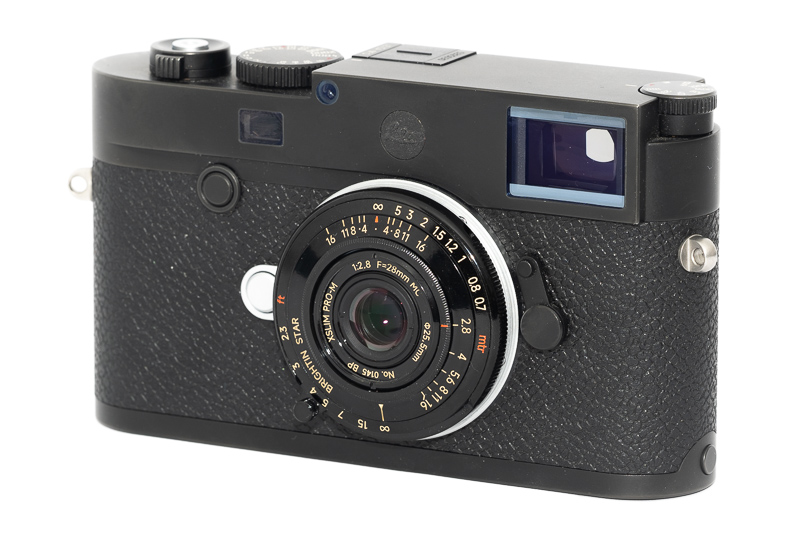
You probably know by now I have a soft spot for the tiny MS-Optics lenses, but there are two major issues with them: they are expensive and the manufacturing quality sometimes leaves something to be desired.
I was always wondering: what if some other company with better manufacturing capabilities would design lenses just as compact? I even pitched the idea to several manufacturers: without success.
But now Funleader and Brightin Star teamed up to do exactly that with this 28mm 2.8 XSlim Pro-M. It looks just like an MS-Optics lens and I have been very curious about it since I first heard of it.
Lens is being tested on 42mp Sony A7rII and 24mp Leica M10
Sample Images





You can find most of the sample images in full resolution here.
Contents
Disclosure
The Funelader x Brightin Star 28mm 2.8 XSlim Pro-M was kindly provided by Funleader for reviewing purposes.
Specifications
The Brightin Star 28mm 2.8 XSlim Pro-M has the following specifications:
-
- Diameter: 51.4 mm
- Field of view: 75.3° (diagonally)
- Length: 9.9 mm
- Weight: 113g (measured)
- Number of Aperture Blades: 10 (slightly rounded)
- Filter diameter: 25.5 mm
- Elements/Groups: 6/5

- Close Focusing Distance: 0.7 m
- Maximum Magnification: 1:21 (measured)
- Mount: Leica-M
You can buy this lens directly from the Funleader.com shop | ebay.com (affiliate links) for $359
Handling / Build Quality

Now obviously this Brightin Star 28mm 2.8 XSlim Pro-M looks a whole lot like the MS-Optics 28mm 2.0 Apoqualia. But it is made from different materials and also handles differently.
This Brightin Star lens is made from brass which not only makes it heavier but also a lot sturdier compared to the MS-Optics lenses that are often made from aluminium.
This lens is also “painted black” which means it might also be subject to “brassing” over time, just like the Leica black paint bodys and lenses.
Similar to the MS-Optics lenses also here on focusing most parts of the lens rotate. The small focus lever sure comes in very handy. The lens rotates ~70° from the minimum focus distance (0.7 m) to infinity. The lens is rangefinder coupled across the whole distance range. Needless to say there is no rangefinder blockage with this lens.
Setting the desired aperture value is also a fiddly endeavour here, but a bit better compared to the MS-Optics 28mm 2.0 MK I I reviewed, as the small aperture ring is thankfully structured here.
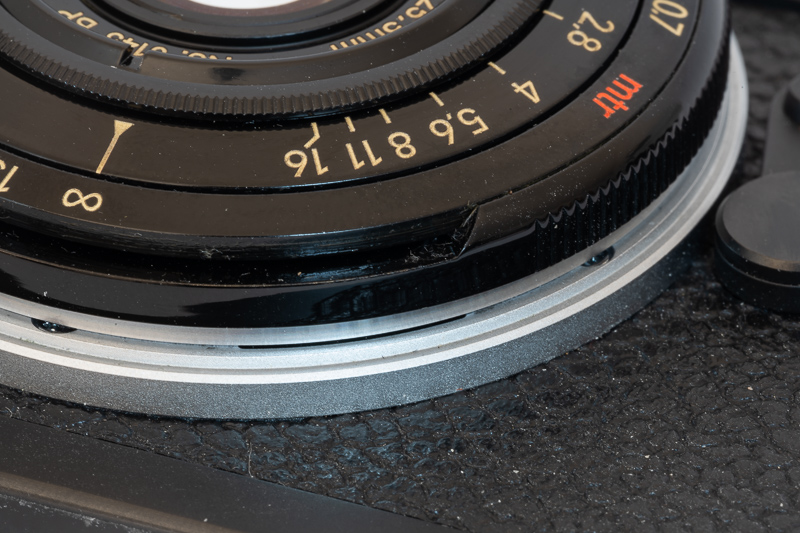
Another unfortunate feature from the MS-Optics lenses also carried over: on the Leica M10 the 6-bit-code-reader is not fully covered and therefore under bright light the camera will often think you changed the lens and throw you ouf of live view should you be using that. Adding a small piece of duct tape solves this issue and this is what I did right after taking these product pictures.

In terms of size this lens is actually in the same ballpark as the MS-Optics lenses which means the lens is barely bigger than a body cap.
If you are wondering what the lens looks like on a Sony camera:

Generally, this Brightin Star lens is a bit easier to operate than the MS-Optics lenses and it doesn’t feel as delicate, definitely more durable.
Vignetting
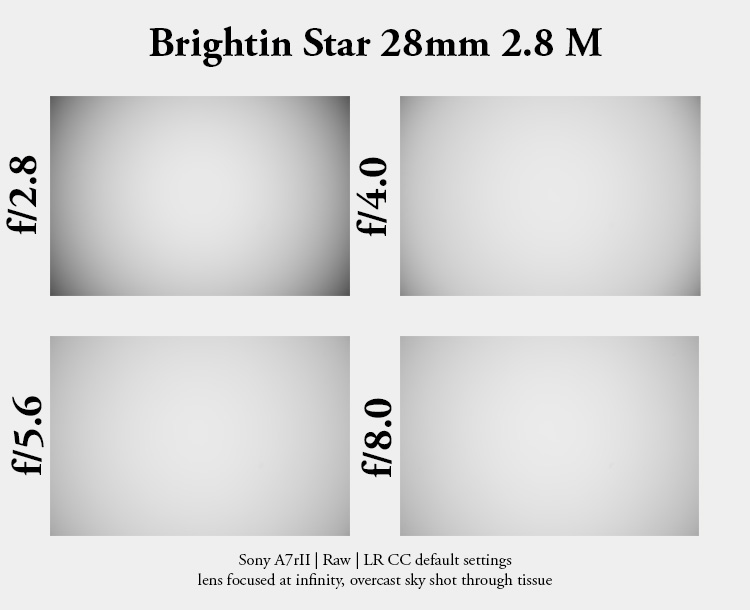
| f/2.8 | 2.9 EV |
| f/4.0 | 2.1 EV |
| f/5.6 | 1.7 EV |
| f/8.0-f/16 | 1.6 EV |
This Brightin Star 28mm 2.8 has a really huge rear element, which in the past has often been good news for the vignetting figures and indeed this is the case here, too.
Now 3 EV vignetting at f/2.8 are a whole lot, but if we compare it to the similarly sized MS-Optics 28mm 2.0 it is almost 1 EV better.

It is recommended to have a look at this article first to get an idea how this brightness graph works.
Sharpness
MTF-Graphs
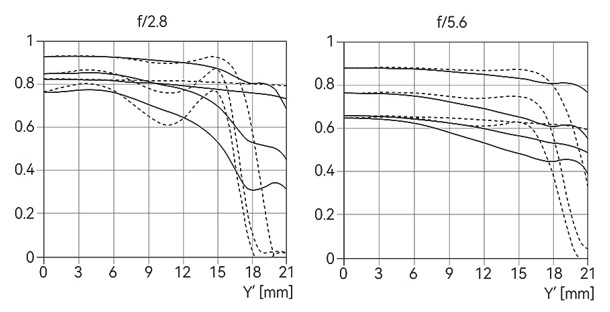
According to the MTF graphs we have very good performance from the center to the APS-C corners, but the fullframe corners show a very noticeable drop in performance.
From these graphs stopping down to f/5.6 does not seem to be enough to improve the corner performance, so let’s see in the following sections if stopping down further helps.
Focus shift
When stopping down from f/4.0 to f/5.6 the focus shifts noticeably to the back. If you want as good as possible sharpness at these aperture settings it might be a good idea to use liveview to focus if possible.
infinity (42mp Sony A7rII, 24mp Leica M10)

In this category the lens performs similar on the Leica and Sony camera, so the following applies to both.
Well, it seems the MTF graphs didn’t lie. The corner performance is really bad and this is thanks to field curvature. You can actually get the corners decently sharp at wider apertures, but then the center will be completely out of focus.
Stopping down obviously increases the depth of field, but even at f/16 this isn’t enough to have the center and the corners in the same focal plane. Not a lens I would want to use for landscape/architecture pictures.
Talking about similarly compact lenses: the MS-Optics 28mm 2.0/1.7 lenses perform pretty much the same, whereas the MS-Optics 24mm 2.0 is doing a much better job, as it shows even across frame performance already at f/8.0 and its field curvature is simply lower- significantly so.
There is something else: on the Leica M10 I used the infinity hard stop for the sharpness chart (which was well calibrated for f/2.0 use) whereas I refocused for every shot on the A7rII. Also similar to the MS-Optics 28mm 2.0 this Brightin Star shows a lot of focus shift on stopping down. This is why the M10’s f/4.0 and f/5.6 series look worse in the center than the f/2.8 one.
So better be careful using this lens in the f/4.0 to f/5.6 range when relying on the rangefinder to focus.
close distance (0.7 m, 42mp Sony A7rII)
At the minimum focus distance and also in the 1.0 to 1.5 m range the sharpness is actually very good at f/2.8 over most of the frame. also in the outer midframe you can get crisp results.
When it comes to the corners there is a whole lot of field curvature, so also at close distances this is not a lens to take pictures of flat objects of.
The sharpness is much higher here compared to the MS-Optics 28mm 2.0 though. The MS-Optics lens is much softer at f/2.0 to f/2.8 and also not as good at resolving fine details.
Flare resistance

The MS-Optics lenses generally perform really bad in this category, so I was especially curious how this Brightin Star lens will perform in comparison.
At the maximum aperture of f/2.8 we can encounter some small artefacts: ghosts, minor internal reflections and ring flares.
Stopped down the ring flares disappear and we mainly have to deal with a few minor ghosts. This is actually a pretty good performance, better than the MS-Optics lenses and also better than both, the TTArtisam 28mm 5.6 as well as the 7Artisans 28mm 5.6.
Coma
100% crops from extreme corner, Leica M10, focus at infinity hard stop
There is very strong coma at from f/2.8 to f/5.6 but the main issue is field curvature. The corners at infinity would be in focus way behind the actual infinity hard stop and as we already show in the sharpness section even at f/16 they are no in the same focal plane as the center. The MS-Optics 28mm 2.0 shows similarly high coma and field curvature.
Distortion
The Brightin Star 28mm 2.8 shows strong but mostly uniform barrel distortion. I found dialing in a correction of +9 in Lightroom/ACR gives very good results and I used this for many of the sample images.
Sunstars
Now potentially you can create really beautiful sunstars with 10 aperture blades, but the alignment of the blades and the manufacturing tolerances are also important. The MS-Optics 28mm 2.0 shows almost no sunstars despite using 10 aperture blades, but this Brightin Star lens actually shows very nice ones from f/5.6.
If you want to learn more about this topic have a look at this article.
Bokeh

In many of the sections we already talked about the high field curvature and it will again be something to talk about here. Similar to the MS-Optics 28mm 2.0 (and 1.7), MS-Optics 35mm 1.3 II Slim as well as that dreadful Zenitar 50mm 0.95 E this Brightin Star lens creates very odd bokeh due to that field curvature.
What is this about? If you look at the motorbike above you can see a defocused background behind the bike in the central part, but the buildings in the corners, which are situated far, far behind the bike, are also in focus. This is because the focal plane bends towards the back. A lot.
In my article Bokeh Explained you can find some further information and examples on this topic.



Me personally, I am not a fan of this behaviour. Those in-focus corner regions often distract from the actual subject and I fail to see the artistic value in that. To me this just looks wrong.
At closer distances (you cannot get that close, because the minimum focus distance is 0.7 m) and with very carefully chosen backgrounds this can be less of an issue though:




Regular readers already know it: I avoid lenses with such field curvature patterns. But I know some people are willing to spend a lot of money for a fast Leica lens which does the same thing and I also know that the MS-Optics 28mm 2.0 has a lot of fans, so maybe this is exactly what you are looking for.
Chromatic Aberrations
lateral
Lateral CA are well corrected, I didn’t find any in my pictures.
longitudinal

There is a bit of green outlining visible in the out of focus areas, but this is still a good performance and generally not something that should worry you in the field.
Also purple fringing is not an issue at all.
Conclusion
good
|
average
|
not good
|
The question here is, what do you expect from this lens?
If you want to use it for stopped down landscape/architecture shooting I think the bad corner performance will bother you – a pity considering flare resistance is not bad and also the sunstars are nice. Me personally, I definitely wish this Brightin Star 28mm 2.8 was sharper across frame stopped down to ~f/11. That way it would be a great “backup” wideangle lens to bring alongside a fast 35 or 50. This is also what I very often use the MS-Optics 24mm 2.0 for, as it sharpens up nicely even in the corners.
If you want to use it for street photography the question is if you are okay with the high field curvature and what it does to the bokeh. But to be fair: the lens is in good company here: the MS-Optics 28mm 2.0 and also the newer 1.7 do just the same.
I you have been intrigued by the MS-Optics lenses but you never pulled the trigger because you thought they were too expensive or you had doubts about their quality control this Brightin Star does give a similar experience for a lot less money. It is not as lightweight, but also feels a lot sturdier and more durable, so a compromise worth considering.
If I had to choose between this Brightin Star 28mm 2.8 and one of the MS-Optics 28mm 2.0/1.7 lenses – and I am sure some of you will ask me exactly that – I would probably go for the Brightin Star lens. They are similarly bad in the corners, the bokeh rendering is similar, but this Brightin Star lens is much shaper over most parts of the frame.
I would – however – rather get the MS-Optics 24mm 2.0 – if I was looking for a super compact lens – or one of the Voigtländer 28mm 2.0 lenses – if I wanted a fast 28mm lens. Both are more costly options of course.
You can buy this lens directly from the Funleader.com shop | ebay.com (affiliate links) for $359
Alternatives
MS-Optics 28mm 2.0 Apoqualia and 1.7:
I already compared these lenses in most of the sections above. They are similarly sized, they look similar and in terms of corner sharpness and bokeh they also perform similar.
The Brightin Star lens is a lot heavier due to a sturdier brass construction and also cheaper as well as easier to get.
I am not the biggest fan of either, so I would go for this cheaper Brightin Star lens.
buy from ebay.com for ~$1200 (affiliate link)
TTArtisan 28mm 5.6:
This lens is similarly small, similarly priced, but 2 stops slower. It does perform much better at infinity and is decently sharp across the whole frame stopped down, but unfortunately it has some issues with lens flares and also has a minimum focus distance of 1.0 m, which I found quite limiting.
buy from manufacturer’s shop and B&H (affiliate link) for $298
7Artisans 28mm 5.6:
This is bigger than the aforementioned TTArtisan lens and also not as sharp stopped down. It has similar issues with flare resistance, also a minimum focus distance of 1.0 m and the sample I had brought up the 35mm framelines. Oh well…
buy from manufacturer’s shop, ebay.com and B&H (affiliate links) for $224
Voigtlander VM 28mm 2.0 Ultron MKII:
The best balanced 28mm lens for M-mount in my opinion. It isn’t nearly as small, but it is still small while packing a whole lot of optical performance.
buy from B&H | ebay.com | ebay.de (affiliate links) for $799
Voigtlander VM 28mm 2.8 Color-Skopar:
This slower Voigtländer lens might not be as small as the Brigthin Star lens reviewed here, but it offers great image quality and handling in a still very compact package.
buy from ebay.com | B&H (affiliate links) for $699
MS-Optics 24mm 2.0 Aporia:
This is not a 28mm lens, but it is one of my favorite MS-Optics lenses and my favorite pancake M-mount lens. This sharpnes up nicely across frame stopped down so I often bring it alongside a fast 35 or 50mm lens in case I need a wider lens. At less than 50g it is never a burden to carry. Of course it also has some interesting quirks, have a look at my review if you want to find out about them.
buy from ebay.com for ~$1000 (affiliate links)
Further Sample Images










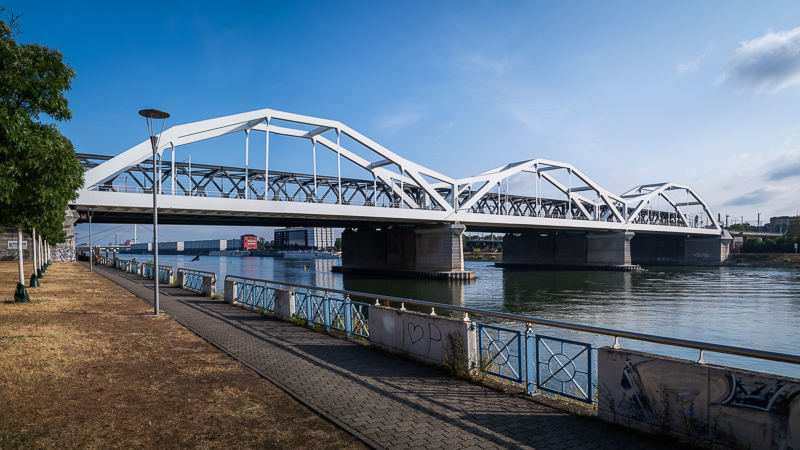



You can find most of the sample images in full resolution here.
Further Reading
- All M-mount lens Reviews
- Bokeh explained
- Review: Laowa 9mm 5.6
- Discuss this review with our Discord community
Support Us
Did you find this article useful or just liked reading it? Treat us to a coffee!
![]()
![]()
![]() via Paypal
via Paypal
This site contains affiliate links. If you make a purchase using any of the links marked as affiliate links, I may receive a small commission at no additional cost to you. This helps support the creation of future content.
Latest posts by BastianK (see all)
- Review: Thypoch 21mm 1.4 Simera - July 12, 2025
- Review: SLRmagic 50mm 0.95 Hyperprime LM - July 5, 2025
- Full Resolution Pictures getting fixed - July 4, 2025
































Bastian’s cautionary remarks give me pause, but his sample images actually leave me feeling pretty confident about my recent purchase of this lens (mine is still making its way across China so I have no experience with it yet.) The secret of my sang-froid: mine will be spending all its time on either an Epson R-D1 or a Pixii A2572 — both of which use Super 35-size sensors, so the scary-looking edge/corner MTF graphs don’t worry me.
One unanswered question potentially important for travel applications: Is there a lens cap at all, and if so how on earth does it attach? There seems to be no physical structure on the lens for such a thing. Thanks…
It comes with a tiny metal screw in lens cap – like the MS-Optics lenses. I find it useless and would never bother with it in the field.
But then I never use lens caps so it wouldn’t really make a difference to me if it shipped with the world’s best lens cap 🙂
I think this lens makes a lot of sense on one of the APS-C bodies!
I would totally buy this lens if it weren’t for the field curvature. Im hoping we can get more lenses like this though.
The pic of the black bicycle @ 2.8 is great! It seems the strength of this lens is close to mid distances wide open. Even if the prices were the same I’d pick this over the MS 28s due to sharpness, flare handling, ease of use and build quality.
I just wish they cut back on all that writing all over the lens!
The samples are very nice as usual and you did a brilliant job to use lens to its strengths concealing its weaknesses! But on the second look the horrendous corners become visible and I can not unsee them 🙁
It really is a pity, because ~80% of the frame actually look really good, but those last 20%…
I quite enjoy a 40mm perspective so perhaps this could be an excellent daily Carry lens for an apsc camera
Thanks for the comprehensive review. When I first saw that its optical design is very different from that of MS 28mm, I thought it must have better performance. I mean, the corners of MS 28mm are basically as bad as things can be right? I guess I was proven wrong. Still, it’s good to see a nicely built little lens at this price point.
The sample pictures corners are not looking so bad as u say, mostly exaggeration, at f11 its just fine.
To be honest, I compared the sharpness section with MS Optics 28 f2 (Leica bodies) and I prefer both the central parts of the picture as well as the corners from the Apoqualia.
MS aimed always at portraiture and the corners it produces are more pleasant for that. Funleader might look more swirly (?) occasionally.
For some reason, the center sections look sharper on MS Optics 28 f2 (most apertures?), despite the declared MTF charts saying something else. ¯\_(ツ)_/¯
Hi Bastian,Thanks for your review!!!! Its image quality is better than I expected. I’m interested in pairing this pancake lens with a Leica CL (the film camera, not the APS-C digital camera). This might be one of the most compact Leica camera setups. However, I’m curious if the metering arm of the CL will affect the focusing of the BRIGHTIN STAR 28mm f/2.8. I have the same concern regarding the MS-OPTICS 28mm f/2.0 as well.
I see what you mean, I am also not sure about that.